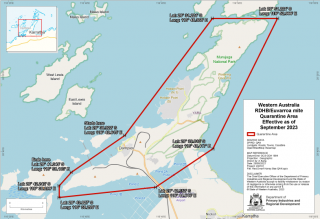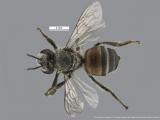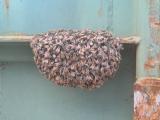DPIRD has been responding to the exotic pest Red dwarf honey bee (RDHB) since September 2023.
The RDHB response aims to eradicate RDHB and the associated ectoparasite euvarroa mite (Euvarroa sinhai) from Western Australia.
All detections of the pest remain confined to a small section of the Burrup Peninsula, and all colonies and abandoned hives have been found within a 1.3 km radius of each other. A Quarantine Area Notice has been placed on the area.
All detected RDHB are euthanised and the remaining hives collected for laboratory testing for exotic mites and viruses. Euvarroa mite has been detected in these samples, but the destructive Varroa mite and other exotic viruses such as deformed wing virus have not been detected.
Please click on the stakeholder update infographic link to the right-hand side of this page for the latest information on the response.
Quarantine Area
A Quarantine Area has been declared for the Burrup Peninsula in the Pilbara (see map) to support a biosecurity response to eradicate RDHB.
Under the Quarantine Area Notice (QAN), Bee keepers with hives, equipment or those who have collected swarms on the peninsula are not permitted to move them outside the Quarantine Area to prevent the pest from spreading.
In addition to a restriction of the movement of honey bee or RDHB, any sightings of the pest must be reported to the department and all DPIRD surveillance equipment must not be interfered with or relocated.
This QAN was amended in July 2024 to include a Control Zone with conditions on clearing of vegetation close to known RDHB infestations.
The control zone restricts the movement of woody vegetation to reduce the risk of spreading RDHB and covers all land in the Murujuga National Park, North of the Rio Tinto Site and on the Burrup Peninsula.
Anyone planning clearing of vegetation in the Control Zone must:
1. Contact the DPIRD RDHB team via PaDIS before you start clearing.
2. Spotters must be engaged to look for and report any insect activity.
3. Any RDHB activity observed during clearing must be reported to DPIRD to arrange for an inspection.
4. All vegetation must be mulched to pieces less than 2.5cm in diameter and must remain on the site from which they were cleared.
The QA is in place until 30 June 2025. Please see the QAN, along with amendments and maps on the right-hand side of this page.
Affected bee keepers are asked to contact DPIRD’s Pest and Disease Information Service (PaDIS) to advise of hives in the area. Workers, residents, businesses and visitors to the Quarantine Area are required to report observations of unusual bees to the PaDIS hotline or via the department’s MyPestGuide® Reporter app to support surveillance.
Distribution
Dwarf honey bees are native to Asia, commonly found in tropical areas.
RDHB is naturally distributed from the Indian subcontinent throughout Southeast Asia through to the Malaysian peninsula.
The dwarf honey bee is not known to be present in Australia.
Impact
RDHB are social bees which live in colonies of at least 3,000 insects. They migrate, swarm, and abscond readily, making them a major threat for exotic incursions and to the Australian environment.
One of the major risks for Australia is that RDHB (Apis florea) is host to a range of bee brood diseases, parasites, and viruses that may impact European honey bees.
RDHB can carry Euvarroa mite (Euvarroa sinhai) a close relative to the destructive Varroa mites. The species can also carry Tropilaelaps mites (Tropilaelaps clareae) which is a known pest of European honey bees.
RDHB may also compete with other bees for floral resources.
What to look for
RDHB are characterised by their external nesting habits. Their nest is made up of an exposed single horizontal comb less than 25 centimetres wide that is built around and attached to tree branches or other support, including buildings and shipping containers.
The pest is easily distinguished from European honey bees by their small size in comparison to the European honey bee, being just 7-10 millimeters in length. They have a red/brown abdomen with black and white bands
Look for unusual bees that look smaller than European honey bees or colonies with exposed combs.
Reporting
Early detection is key to protecting Western Australia’s valuable bee and horticultural industries. Immediately report any unusual bees or nests.
Members of the public and workers in the area are encouraged to report sightings of any exotic bees in the area to assist in ensuring no further red dwarf honey bees are present.
If you work at a port or transport imported goods and shipping containers, you must report any sighting of bees associated with these goods. Exotic bees are a pathway for bee pests and viruses so they must be reported
DPIRD Pest and Disease Information Service
MyPestGuide®
Beekeepers
Beekeepers in the Karratha region, including the Burrup Peninsula, are encouraged to report the location of their apiaries to assist with surveillance. Managed European honey bee hives can be reported via this form or by calling the Pest and Disease Information Service (PaDIS) on (08) 9368 3080.
Mite surveillance activities can be reported via our report honey bee mite surveillance results online form
. Please report the locations of wild European honey bee nests using MyPestGuide®. Reports can also be made by calling our department’s Pest and Disease Information Service (PaDIS) on +61 (0)8 9368 3080.





